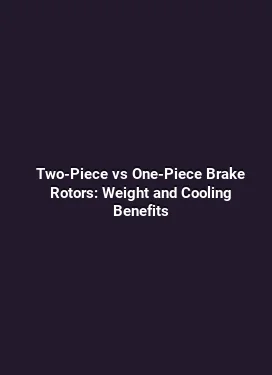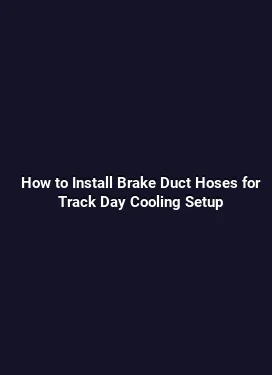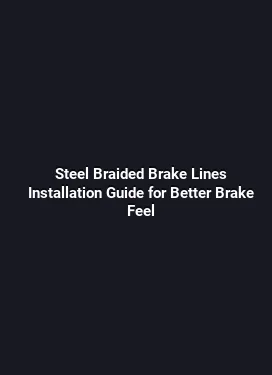Best Budget Brake Pad Compounds for Street and Track Use Under $200
Understanding Budget Brake Pad Compounds for Dual-Use Street and Track Applications

Budget brake pad options are no longer limited to the era of noisy, crumbly formulations. Today’s affordable compounds are engineered to deliver a practical balance between initial bite, fade resistance, disc-friendly wear, and low dust generation. When selecting under $200, the goal is to identify compounds that provide reliable daily drivability while still offering predictable lap-time consistency on a track day. The key is recognizing how the pad compound behaves across a range of temperatures and surfaces, from cold street start-ups to hot, demanding track sessions.
On the street, a pad should deliver smooth engagement, modest noise, and reasonable wear rates for rotors and calipers. On the track, the same pads must maintain consistent friction as temperatures rise, resisting fade and maintaining predictable, linear response. This dual-use mindset helps narrow choices to three broad categories: towards the milder end for everyday driving, mid-range compounds that strike a balance, and more aggressive street/track hybrids designed for occasional track sessions while remaining street-friendly.
H3 First Subtopic: Material Foundations and How They Impact Real-World Use

Brake pad materials fall along a spectrum from organic and semi-metallic to ceramic and carbon-ceramic blends. For budget options under $200, most common families are organic or semi-metallic blends. Organic pads typically use fiber-reinforced binders and non-metallic fillers, offering low noise and rotor friendliness, but they can wear faster and have a narrower temperature operating window. Semi-metallic pads incorporate small amounts of metallic content to raise friction stability at higher temperatures, improving fade resistance at the expense of more rotor wear and potential noise. In a performance-minded, budget-conscious scenario, semi-metallic options are frequently the sweet spot because they provide consistent bite and fade resistance without the premium price tag of high-end ceramic or carbon-ceramic solutions.
Some budget pads implement advanced shims and slots to manage heat and gas build-up, helping to preserve pad life and rotor condition during repeated stops. Always pay attention to rotor condition and caliper compatibility, as improper fitment can alter pad alignment and heat dissipation, impacting overall braking performance. The practical takeaway is that you do not have to chase the most aggressive compound to achieve track-ready performance; you need a dependable balance between bite, fade resistance, and rotor wear that fits under a $200 cap.
Key Factors to Consider for Street and Track Use Under $200
When evaluating options, several practical factors drive real-world performance more than any marketing claim. Temperature range is critical: street sessions occur at ambient temperatures with less heat build-up, while track use raises temperatures quickly. A pad’s friction material must perform steadily from cold initial bite to mid-range heat and finally high-temperature conditions without sudden changes in feel. Rotor wear, noise, dust generation, and modulation (how smoothly the pad responds to pedal input) are equally important for daily usability.
Another important consideration is noise management. Budget pads can be louder than premium options, especially when the rotor surface is glazed or contaminated with debris. Pads with improved cut-in surface geometry and optimized backing plates often reduce vibration and ring, delivering a more linear feel through the pedal. Compatibility with your caliper and rotor size is essential; even a slightly mismatched pad can create uneven wear or inconsistent bite, undermining both safety and performance.
H3 Porous Media and Heat Management
Heat management is a practical aspect that affects pad performance. Some budget pads incorporate resin binders and mineral grains designed to dissipate heat more evenly, preventing hot spots that lead to fade. A pad with good hot-weather stability maintains friction coefficient across a wider temperature band, providing confidence on track days and predictable braking in spirited street driving.
For street use, a pad that achieves a strong cold bite is valuable, reducing the distance required to bring the car to a stop after a long period of idle. On track days, consistent bite without drastic changes as temperatures climb is the hallmark of a well-designed budget compound. When shopping, note user experiences about fade resistance in real-world track sessions and cross-reference with rotor wear expectations to gauge long-term value.
Popular Budget Pad Choices Under $200 for Street and Occasional Track Use
Here are common candidates that often land in the under-$200 category, chosen for their balanced performance and broad availability. Each option tends to offer a distinct advantage, whether it is cleaner rotor interaction, steadier bite, or better street manners. Availability can vary by market, so consult local retailers and performance shops for current pricing and fitment options.
Option A typically emphasizes a smoother initial bite with predictable wear characteristics, making it a comfortable choice for daily driving while still offering enough performance during weekend track sessions. Option B may push a bit more on braking force and heat tolerance, trading some rotor wear for stronger stopping power on demand. Option C often features reduced dust output and quieter operation, which benefits daily usability on mixed road surfaces. Across these options, the best approach is to align pad choice with your daily rhythm, track frequency, and rotor health.
H3 Real-World Use Scenarios and How to Choose
For a daily driver who attends a few track days each season, selecting a pad with strong cold bite and low rotor wear is often ideal. If the track sessions are frequent or you drive aggressively on the street, a pad with better high-temperature stability and fade resistance may be more suitable, even if it means slightly more rotor wear and noise. For a vehicle used primarily on roads with occasional spirited driving, a balanced option that minimizes dust and noise while delivering predictable braking is typically preferred. The key is to assess your typical braking demands and annual mileage, then map those needs to a compound that offers the most consistent performance under your conditions.
Bed-In Procedures and Maintenance for Consistent Performance
Proper bedding-in of new pads is essential for achieving reliable friction behavior and maximizing pad life. The process typically combines an initial gradual heating sequence with a series of controlled stops to establish a uniform friction coating on the rotor surface. A common bedding procedure involves mild, progressive braking from a moderate speed, followed by a cooling period to allow the pad material to anneal without thermal shock. This routine helps establish consistent bite and reduces the risk of glazing, which can hamper initial response and pad life.
Maintenance between sessions includes inspecting pad thickness, rotor condition, and any glazing or glazing indicators. If you notice excessive pad dust, rotor scoring, or unusual noises, it may indicate the need to rebed or inspect caliper hardware such as guide pins and pistons. Regular checks ensure that brake balance remains stable and that pad wear remains within expected limits, particularly when using budget-wide options for track days.
H3 Bedding, Break-In Cycles, and Safety Considerations
Bed-in cycles should be performed in safe conditions with minimal traffic and on a dry surface. The process helps establish uniform friction coating and reduces pedal fade under load. For drivers who frequently switch between street and track, keeping rotors within a healthy wear window is important, as overheated rotors can alter pad performance. Always verify that pad material is compatible with your rotor material and that the caliper’s piston travel is not restricted by corrosion or grime, which can affect the even transfer of friction material to the rotor surface.
Brake Feel Across Surfaces and Driving Scenarios
Different road surfaces, weather conditions, and tire grip levels influence how a pad feels to the driver. In dry, high-grip conditions, a budget pad may provide a confident, linear response, enabling precise modulation during corner entries and brake zones. In wet or cool conditions, pad response can shift; some compounds maintain bite better than others, and those with robust moisture handling tend to deliver more predictable performance when traction is changing. For track practice on a mixed-surface day, it helps to know your pad’s cold-to-warm transition, so you can plan brake aggression accordingly without compromising control.
Drivers should also pay attention to pedal feel changes as rotor temperatures rise. A pad that remains linear and predictable across a broad temperature range reduces the risk of abrupt late braking or pedal travel surprises, which is especially important on venues with tight braking zones. The practical takeaway is to test a chosen pad under a few different load scenarios—low-speed city stops, highway decel, and track sessions—to understand its behavior before relying on it exclusively for critical braking moments.
H3 How to Compare Pads without Quick Judgments
Comparative testing can be done by noting initial bite, progression, and fade resistance under controlled conditions. Even in a street-legal setup, a track-day-ready option should demonstrate stable friction across repeated stops and maintain consistent pedal feel as heat builds. Documenting subjective impressions alongside quantitative checks, such as pad thickness at service intervals and rotor wear indicators, provides a practical basis for selecting a durable, affordable pad that matches your vehicle and driving style.
Sizing, Compatibility, and Installation Considerations
Before purchasing, confirm you have the correct pad shape and backing plate width to fit your caliper system. Pads designed for a specific rotor diameter and thickness may differ in thickness, which affects caliper clearance and pad retention. If a pad sits too tight or too loose, it can alter engagement feel and heat transfer, plus raise the risk of uneven wear. It is also wise to verify hardware compatibility, such as the presence of anti-rattle clips and piston seals, which influence noise, vibration, and pad alignment.
Practically, the installation process should include a clean rotor surface, fresh hardware if needed, and careful torquing of mounting bolts to manufacturer specifications. After installation, perform a cautious bedding-in and a final system check with light, progressive stops to ensure even contact. Consider maintaining a rotation schedule for rotors and pads to balance wear across all wheels, especially if the vehicle operates in varied driving conditions throughout the year.
H3 Real-World Tips for Maximizing Budget Pad Performance
Keep an eye on rotor condition; warped or deeply scored rotors can undermine pad performance more than any property of the friction material itself. If you notice irregular pedal feel, inspect caliper pins for lubrication and free movement, ensuring there is no sticking that could cause uneven pad contact. Periodic rotor resurfacing or replacement, aligned with pad life, can help preserve consistent braking behavior, particularly for vehicles used in aggressive street driving or on frequent track days.
Putting It All Together: Practical Recommendations for 2025 and Beyond
Budget brake pad options under $200 can deliver very respectable performance for street use with occasional track days when chosen with care. Focus on compounds that offer linear bite, broad temperature stability, balanced rotor wear, and manageable noise. When possible, reference real-world user feedback and technical notes from reputable shops or performance centers to understand how a given compound performs in conditions similar to your own vehicle and climate. The goal is clear: a dependable, predictable braking experience that respects both daily usability and the occasional track excursion, all without exceeding the price ceiling.






